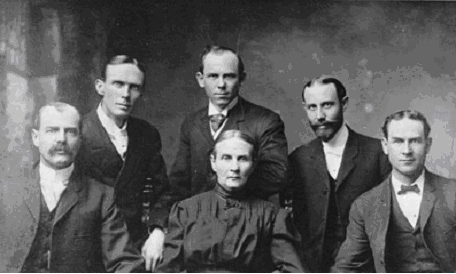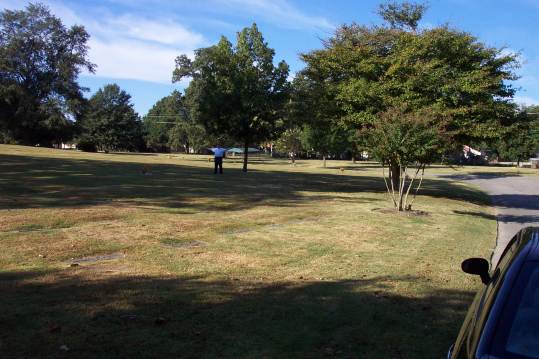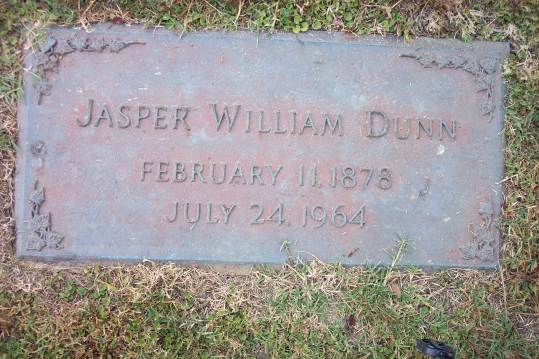Jasper William Dunn, Sr.
1878-1964

John, Jim, Jasper W., G.A.
(Gus), Tom.
Jasper W. Was One Of
The Five Dunn Brothers Who Preached The Gospel In The Early 20th
Century
![]()
Info On J.W. Dunn
from Ancestry.com
A highly respected and esteemed citizen of Dyersburg is Rev. Jasper William Dunn, pastor of the Christian church here. He was born in Readyville, Rutherford county, Tennessee, on the 11th of February, 1878, a son of Thomas Franklin and Levisa Elizabeth Dunn, the seventh child of a family of five boys and four girls. His grandfather's sister was the mother of President Andrew Johnson. This family of Dunns came from Dublin, Ireland, in the colonial days. Andrew Dunn, fifth generation back, was a revenue collector in Dublin, Ireland, and the name Dunn is said to have been given him from the nature of his office. On coming to the United States [p.341] he located in Pennsylvania and subsequently married. One son was born to this union, Andrew, by name. Later in life Andrew Dunn, Sr., removed with his family to Virginia and there his demise occurred. The son Andrew located in North Carolina and his demise occurred in that state. He left a son, John, who married Mary Allen and moved to Rutherford county, this state, in 1812. John Dunn had four sons: John P. William, Andrew, Wilson and Leander; and four daughters, Elizabeth, Patsy Jackson, Lottie and Margaret Benson. John P. Dunn had six boys: William, James, McGuire, John Andrew, Thomas Franklin and Albert; and three daughters, Emelyne, Mary and Margaret. Thomas Franklin Dunn, the father of Jasper William Dunn of this review, married Levisa Elizabeth Nelson, daughter of Evan Nelson and greatgranddaughter of Scotch Tom Nelson, one of the signers of the Declaration of Independence, who came to this country from Penrith county, England. Levisa Nelson Dunn was a descendant of the Adamses and Tennysons on her mother's side and of Lord Nelson of England, on her father's side.
In the acquirement of his early education Jasper William Dunn attended the public schools of Readyville, Tennessee, and after graduating from the local high school he enrolled in the Winchester Normal School at Winchester. Subsequently he became a student at Peabody College in Nashville and like his four older brothers, when he reached his twenties, he entered the ministry of the Church of Christ. He has since been active in a ministerial capacity as pastor of the Christian church in Dyersburg. He is one of this community's most highly esteemed citizens. On the 23d of December, 1909, was celebrated the marriage of Mr. Dunn to Miss Margaret May McGill, a daughter of Dr. and Mrs. H. D. McGill, the ceremony being performed at the home of the bride in Clarksburg. To their union four children have been born: Margaret Grace, twelve years of age; Jasper Wilborn, nine years of age; Miriam May, six years of age, and Homer McGill, aged four years. Mr. Dunn is committed to no one political party but gives his support to the man best fitted for the office, without regard for party principles. He is one of Dyersburg's most liberal-minded citizens and no movement for public development and improvement seeks his aid in vain. His has been a busy life, preaching in most of the southern, western and some of the northern states, holding pastorates in some of the largest cities of the south and west, and wherever he has preached he has had a large and devoted following.
-Tennessee, The Volunteer State, 1769-1923, Vol. 4, from Ancestry.com
![]()
The Gospel Restored In Memphis
The Essential Element
What does it take to plant a church in a new place? While time and circumstances may necessitate different approaches, one element remains the same: it takes at least a few people who are thoroughly dedicated to the kingdom of God.
Nowhere is this seen more clearly than in the beginnings of the Lord's work in Memphis, Tennessee, at the turn of this century.
While Memphis faced the twentieth century with a population of slightly less than one hundred thousand, the cause of New Testament Christianity was almost new there. The Linden Avenue Christian Church, the "mother church" of the city, established in 1845 by Dr. B. F. Hall, had already accepted instrumental music and missionary societies and for all practical purposes was a full-blown liberal denominational church. So were the other two Christian Churches in the city. A few brethren were unwilling to accept the innovations, but were not meeting to worship and serve God as his word taught.
That was the situation in 1899 when J. H. Harden came to the city to manage a "manufacturing plant." Harden rounded up about thirty disciples to worship each Sunday, first in their homes, then in the Odd Fellow's Hall. Harden's removal to Anniston, Alabama, in a few months left the group without leadership, so by the time James A. Harding arrived in June, 1900, it was difficult to get a dozen people together to agree to meet regularly. Harding hoped "to create an interest in primitive Christianity in that city," and pitched his tent in the hopes of attracting large crowds. Although he did this, when he left eventually, the few disciples dwindled again and interest lagged.
But Memphis was too important a place to be neglected for long by zealous brethren. Many thought it was the fastest growing southern city. A. G. Freed saw the great opportunity three years later and began his efforts in July, 1903. The meeting, which was held in the Women's Building, lasted only ten days and began with small audiences, but the crowds grew and the services ended with ten additions, and the tally now showed the church had thirty-two members. R. E. McCain, one of that number, was optimistic. He believed there were at least one hundred members scattered over the area who needed to be rounded up. "We believe, now, that the cause of primitive Christianity is firmly planted here, and every effort will soon be made to purchase a lot and build us a house in which to meet as a center from which to establish other congregations in the city," he wrote. Still, for a few months, the work lagged.
It wasn't until the coming of John E. Dunn to the city late that same year that the brethren were alerted to the great possibilities. After attending the Stark-Warlick debate in Henderson, Tennessee, Dunn went on to Memphis where he spoke nightly in the Trinity Baptist Church and saw the great possibilities for the work. He wrote shortly afterward, "I fully believe that Memphis is one of the neediest and most inviting fields within my knowledge." Dunn, the preacher for the Tenth Street church in Nashville, was in no position to move to this West Tennessee city at the time. Although some brethren had moved away and the membership of the church had now dropped to just twenty-five, Dunn was convinced the church would grow, but "to make the effort a success will require hard work and sacrifice." He was right.
Dunn spent half of the next July in Memphis, preaching on the second floor of the Women's-Building, corner of Jefferson and Third Street, two blocks northeast of the Court Square. Audiences grew, mostly because Dunn walked the streets trying to round up derelict members. Zeal was picking up among the few members and Dunn considered the congregation "full of faith and good works." Increasingly Dunn visualized that the church would "become more and more a power for good in Memphis and the adjoining territory."
Although the congregation was receiving strong opposition, mainly from the digressives who wanted to hold the territory for themselves, the little congregation was attracting attention of many people over the South. McCain wrote, "It is gratifying to our little congregation here to know that the possibilities of this great and growing city are beginning to receive attention by brethren in Nashville and other parts of the state.... There is possibly not a more inviting field in Tennessee than Memphis and yet the work is by no means easy of accomplishment."
Although the small church was, by the summer of 1904, showing considerably more zeal, its membership remained about thirty. Evangelistic meetings had stimulated the work but only temporarily. Dunn was now convinced that the work would not grow until a strong preacher moved to the city who would do house-to-house work and hold tent meetings all over the area. The problem was that the small group could not support a preacher, so Dunn went to work to raise funds for the right man. He talked to people about the work, wrote articles in the GOSPEL ADVOCATE appealing for funds and even t got David Lipscomb to push it. Lipscomb said, "Every church and every Christian in Tennessee ought to feel an interest in the work. Especially this is true of the churches in West Tennessee." When it was evident the funds would come in, Dunn persuaded his brother, J. W. (Jasper), to do the necessary work.
On November 1, 1904, Jasper moved to the city and soon met with the thirty disciples, whom he described as meeting in the southwest part of the city, near the Mississippi River. Jasper, too, saw the possibilities. "A strong church established in this city, loyal and zealous for the truth, like the churches of Antioch and Jerusalem at the beginning, would do a great work in `holding forth the word of life.'" When he met the members, he found Lafayette Morgan, B. B. Goodman, W. B. Morgan, R. L. Carter, who lived in Memphis, and T. E. Tatum, who was there only temporarily to help with the work. Jasper plunged into the work with all his power. In three months he wrote to J. C. McQuiddy, "I feel like all will work out well here in the course of time. I am a firm believer that when I do my duty, live as the Record directs, preach the 'unsearchable riches of Jesus Christ,' God will care for me...." It took such faith to do the work.
The coming of A. M. St. John, a traveling salesman for the Memphis Furniture Company, proved also a great boon for the work. St. John considered Henderson his home where he had been a power in turning the cause away from the digressive forces that almost took it over. A nephew of E. G. Sewell, one of the editors of the GOSPEL ADVOCATE, he possessed an untiring zeal for the cause of primitive Christianity, though he seldom made public addresses. It was a blow to Memphis when the forty-seven year old brother passed away in 1908 and was buried at Henderson.
With such inspiring help, the church staged a continuing but small growth. In the months following Jasper's arrival, brethren worked hard with a view to the coming of E. A. Elam, one of the most eloquent and powerful preachers of the time, who arrived in November, 1905, for an evangelistic meeting. Elam closed a two weeks' effort with what the Commercial Appeal called an "eloquent and impressive" sermon on "Obedience." With emotions high a contribution was taken to raise money for a lot and building. Elam helped find a proper lot, on Gaylord Avenue, near the end of the electric car line. The building went up and the opening service was held January 22, 1907. G. A. Dunn, Jasper's brother, preached that day and said, "We rejoice with these brethren, and shall watch their work with much interest. Memphis is an important place and the opportunities for doing good are great."
In the years ahead, the tireless efforts of W. S. Long, Jr., would build on this foundation and the work would not be easy. But the foundation was laid by now and the cause of New Testament Christianity was ready to expand.
-Earl West, Gospel Advocate, Volume CXIX, Number 17, April 28, 1977 pages 262,263
![]()
Directions To The Grave Of Jasper W. Dunn, Sr.
J.W. Dunn, Sr. is buried in the Memorial Park Cemetery in Memphis, Tennessee. Take I-240 to Poplar Ave exit. Go west and the cemetery will be on your right. The Dunn monument is located in Section H, Row B, Lot 14, Space 5
See Memorial Park Webpage and Map To Dunn Grave Here!
GPS Coordinates
35°06'29.2"N 89°52'33.4"W
or D.d. 35.108115, -89.875944

Grave Located Where Friend, Graham McDonald, Is
Standing, Visited October, 2004


Special Thanks to Betty Lou Dunn Camp for the picture of the Dunn Brothers Above. In addition to being related to the Dunn family, she lives in Talladega, Alabama and is related to the Franklin Camp family as well.
![]()